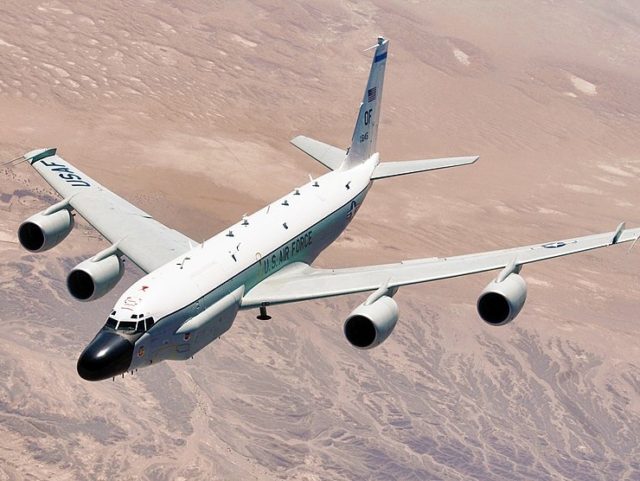The United States deployed a reconnaissance aircraft that specializes in monitoring missile launches to Japan over the weekend, possibly to make it ready for monitoring North Korea’s recently refurbished ballistic missile test sites.
Stars & Stripes on Tuesday published reports from Okinawa about the arrival of the aircraft, noting that it might also have been moved because of flooding at its normal hangar in Nebraska:
An Air Force RC-135S Cobra Ball landed at Kadena Air Base on Saturday evening, according to Satoru Kuba, an Okinawan who monitors military aircraft traffic for Japan’s Fuji Television. The 135-foot-long, Cold War-era aircraft was parked in a hangar and was still at Kadena as of Tuesday.
North Korea has rebuilt a launch site at Sohae that it had partially dismantled as part of disarmament steps last year, according to recent satellite images. However, the Cobra Ball’s deployment could also be related to flooding at Offutt Air Force Base, Neb., where the Air Force’s three Cobra Ball aircraft are permanently based.
All Cobra Balls are operated by the Air Force’s 55th Wing and manned by crews from the 45th Reconnaissance and 97th Intelligence squadrons, according to an Air Force website.
Kuba said the aircraft stopped in Europe, the Middle East, Diego Garcia and Indonesia before arriving in Japan. He said the rest of the 55th Wing deployed to MacDill Air Force Base, Fla.
An official with the Okinawan Ministry of Defense intriguingly told Stars & Stripes his office was not made aware of the Cobra Ball’s arrival.
The RC-135S Cobra Ball is precisely the sort of aircraft that would be deployed on short notice to closely observe activity at a North Korean missile site. The same platform was used to monitor activity in North Korea prior to its “diplomatic opening” to South Korea and the United States last year.
South Korean officials said on Monday that North Korea might be about to test-launch a missile from the restored Sohae Satellite Launching Station, which has been undergoing renovations since shortly before the summit between U.S. President Donald Trump and dictator Kim Jong-un in February.
There has been much speculation among observers as to whether Pyongyang performed these renovations merely to increase pressure on the U.S. during negotiations, knowing full well that satellite photographs would pick up the activity, or if the North is seriously preparing to conduct a new missile test disguised as a “satellite launch.” The last such launch occurred in February 2016. Kim promised to dismantle the Sohae facility at a summit with South Korean President Moon Jae-in in September.
South Korean analysts said on Tuesday they believe an imminent launch is unlikely, as the North has rebuilt Sohae but has not resupplied it with the equipment necessary to actually launch a rocket. They added that missile parts and launch equipment can be moved to the facility fairly quickly if Pyongyang decides to proceed with a missile test.
South Korean Defense Minister Jeong Kyeong-doo, speaking from Washington after a meeting with Acting U.S. Defense Secretary Patrick Shanahan, said it is still too early to tell if Sohae was reconstructed for show or if Pyongyang seriously intends to use the facility again.
South Korean officials pointed to North Korea pulling out of several recent denuclearization meetings at the last minute as a sign the diplomatic thaw is ending and Pyongyang could be gearing up for fresh provocations. One of those recalcitrant North Koreans is Vice Foreign Minister Choe Son-hui, who was both a key player in arranging the Trump-Kim summit in Hanoi and a primary source of threats that the unsuccessful conclusion of the summit would have dire consequences.
President Moon’s office signaled over the weekend that a special envoy may be sent to Pyongyang in a last-ditch effort to keep diplomacy alive. Moon, who will meet with President Trump in two weeks, warned on Monday that “if dialogue fails at this moment, the situation will become even worse.”

COMMENTS
Please let us know if you're having issues with commenting.